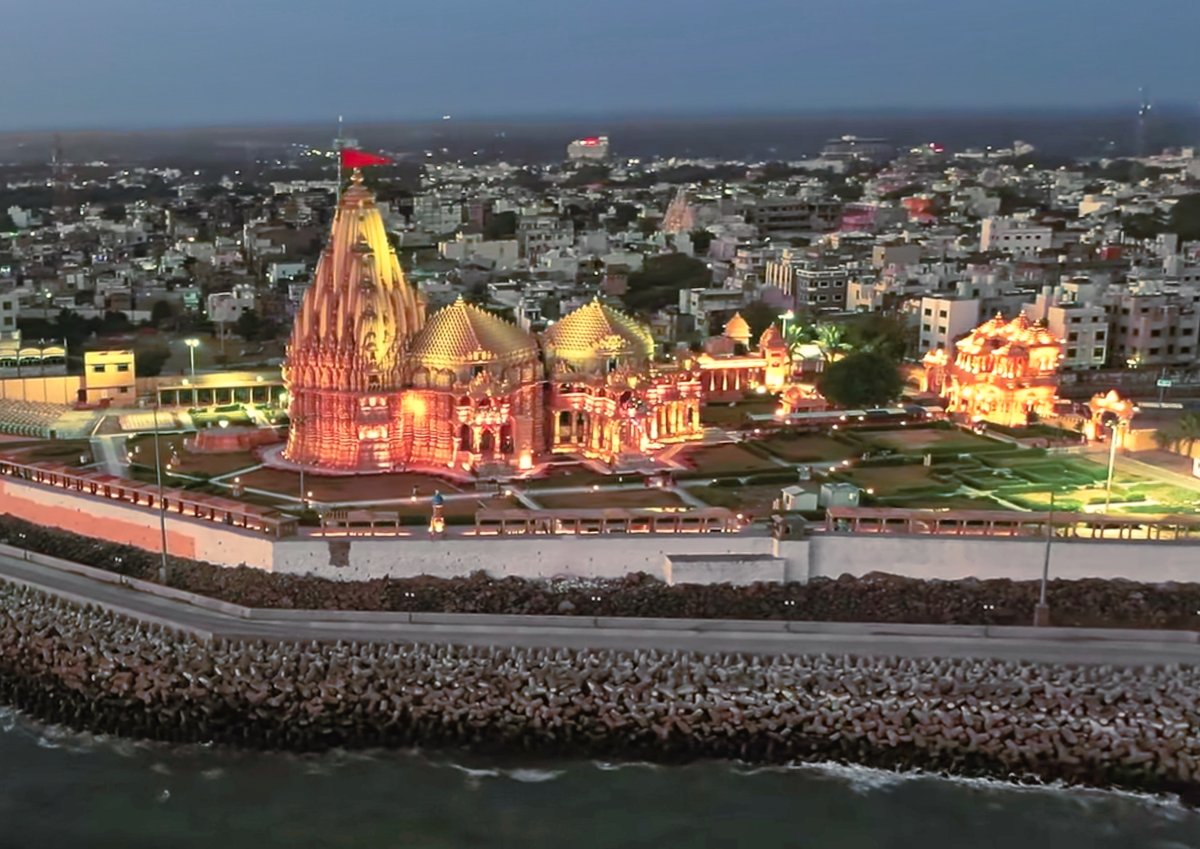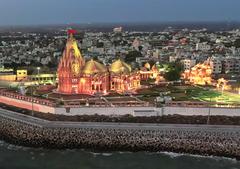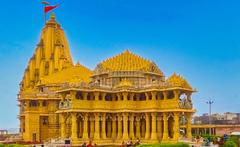
Somnath Temple: Visiting Hours, Tickets, and Travel Guide in Veraval
Date: 14/06/2025
Introduction
Nestled along the Arabian Sea near Veraval in Gujarat, the Somnath Temple is one of India’s most venerated Hindu shrines and a key historical landmark. Celebrated as the first of the twelve Jyotirlingas—sacred manifestations of Lord Shiva—the temple’s history is marked by cycles of destruction and reconstruction, reflecting both spiritual devotion and national resilience. Its majestic Chalukya-style architecture, mythological origins, and role in Indian culture make it a premier destination for pilgrims, history enthusiasts, and architecture lovers alike (templeyatri.in; lovelytinythings.com; gujaratexpert.com).
This guide provides a detailed overview of Somnath Temple’s historical legacy, architectural features, visiting hours, ticketing options, accessibility, and travel tips, ensuring you have all the information needed for a meaningful and memorable visit.
Historical Overview
Mythological and Ancient Foundations
Somnath Temple’s origins are steeped in Hindu mythology, with references in ancient scriptures such as the Rigveda, Skanda Purana, and Mahabharata (templeyatri.in; ramkebhakt.com). According to legend, Soma, the Moon God, built the original temple in gold to seek Lord Shiva’s forgiveness, giving rise to the name “Somnath” (“Lord of the Soma”). Over time, reconstructions by Ravana (in silver) and Lord Krishna (with sandalwood) are also attributed in mythological accounts (unacademy.com).
Archaeological evidence suggests that the temple site, Prabhas Patan, has been inhabited since the Indus Valley Civilization, with the earliest temple structures dating back to between the 5th century BCE and the early centuries CE. Throughout history, the temple has served as both a spiritual center and a maritime landmark (hindutsav.com; gujarattrips.com).
Medieval Destruction and Rebuilding
Somnath’s history is characterized by repeated invasions and reconstructions. The most infamous attack occurred in 1025 CE, when Mahmud of Ghazni plundered and destroyed the temple (gujarattrips.com; hinduculturehub.com). Over the centuries, the temple was rebuilt by several rulers, notably King Bhimadeva I of the Solanki dynasty in the 11th century, and again after subsequent invasions by Alauddin Khilji and Mughal emperors (hindu.mythologyworldwide.com).
Modern Era: Symbol of National Revival
During British colonial rule, the temple’s ruins were documented by historians and archaeologists. After independence, Sardar Vallabhbhai Patel led the temple’s reconstruction, completed in 1951 in the Chalukya architectural style. The new structure stands as a symbol of India’s cultural revival and unity (thehindutales.com).
Architectural Features
Chalukya (Solanki) Style
The temple is an outstanding example of Chalukya architecture, characterized by its soaring shikhara (spire), intricately carved pillars, and detailed stonework. The current structure, designed by P.K. Acharya and constructed by the Sompura Salats (master masons), reaches a height of about 155 feet and is crowned by a 10-tonne kalash (finial) (e-a-a.com; gujaratexpert.com).
Structural Layout
- Garbha Griha (Sanctum Sanctorum): Houses the Jyotirlinga, crafted in sandalwood and sandstone.
- Sabha Mandap (Assembly Hall): A large space for congregational worship and rituals.
- Nritya Mandap (Dance Hall): Features ornate columns and a loadstone ceiling (gujaratexpert.com).
- Courtyards and Outer Walls: Adorned with mythological carvings and processional paths (templeyatri.in).
Integration with the Landscape
Strategically built on the Arabian Sea coast, the temple’s alignment ensures no land is visible between Somnath and Antarctica, symbolizing spiritual continuity. Elevated foundations and interlocking stone ensure durability against erosion and seismic activity (gujaratexpert.com; e-a-a.com).
Visiting Somnath Temple: Practical Information
Location and Accessibility
- Address: Somnath Mandir Rd, Prabhas Patan, Gujarat 362268 (Somnath.org)
- By Air: Nearest airport is Diu (63 km), with connections to the temple via taxi and bus.
- By Train: Veraval Railway Station (5 km), connecting to major cities.
- By Road: Well-connected by highways with regular bus and taxi services (thetemples.in).
Visiting Hours and Tickets
- Temple Hours: 6:00 AM – 10:00 PM daily (indiathrills.com).
- Aarti Timings:
- Morning: 7:00 AM
- Noon: 12:00 PM
- Evening: 7:00 PM
- Light and Sound Show: 7:45 PM – 8:45 PM; tickets (INR 30–50) available on site after 6:00 PM (thetemples.in).
- Entry Fees: General darshan is free. VIP darshan tickets cost INR 500 per person, with priority entry and special pooja services (indiathrills.com).
Darshan and Rituals
- General Darshan: Open to all during temple hours.
- VIP Darshan: Expedited entry and personalized pooja experiences.
- Special Poojas: Book in advance for rituals like Rudra Abhishek, Panchopchar Pooja, and Maha Mrityunjay Jap (indiathrills.com).
- Online Darshan: Available through the official website and select TV channels.
Accessibility
- Wheelchair ramps and accessible pathways are available.
- Cloakrooms, clean restrooms, and rest areas for elderly and disabled visitors (gujarattrips.com).
Dress Code and Conduct
- Dress Code: Modest clothing is required; sarees, dhotis, pants, and knee-length skirts are permitted. Avoid revealing outfits (indiathrills.com).
- Conduct: Maintain decorum, respect rituals, and adhere to temple guidelines. Photography is prohibited inside the main sanctum.
Festivals and Special Events
- Maha Shivaratri: The most significant festival, attracting thousands of devotees with night-long prayers and processions.
- Shravan Somvar and Kartik Purnima: Major rituals and cultural events.
- Diwali: The temple is beautifully illuminated (coveringindia.com).
The daily aarti ceremonies are accompanied by Vedic chants, creating a spiritually charged ambiance.
Facilities, Accommodation, and Dining
Accommodation
- Temple Guest Houses: Sagar Darshan Guest House, Lilavati Atithi Bhavan, and Maheshwari Atithi Bhavan offer rooms starting from INR 1,300–3,000 per night. Book online via the official website (thetemples.in).
- Hotels: Wide range available in Veraval and Somnath.
Food and Prasad
- Temple Prasad: Distributed to devotees; available to take home as blessings (thekarmaatimees.in).
- Nearby Restaurants: Options include Shiv Ganga Restaurant, Safari Hotel & Resort, and Hotel Aditya Mansingh Inn (wanderlog.com).
Other Amenities
- Cloakrooms, security screening, and first-aid services are provided.
- Mobile phones and cameras are not allowed inside the main temple; lockers are available for safe storage.
Nearby Attractions
- Bhalka Tirth: Where Lord Krishna is believed to have been wounded.
- Triveni Sangam: The confluence of three rivers.
- Dehotsarg Tirth, Laxmi Narayan Mandir, Surya Mandir, Kamnath Mahadev Mandir, and Somnath Beach (wanderlog.com).
- Gir National Park: Home to Asiatic lions, about 65 km from the temple.
Best Time to Visit
- Ideal Season: October to February (15°C–28°C) offers pleasant weather. Summers are hot, and monsoons bring heavy rainfall (thetemples.in).
- Major Festivals: Maha Shivaratri and Kartik Purnima see the largest crowds.
Booking and Contact Details
- Online bookings: Darshan, pooja, and accommodation can be reserved via the official website.
- Contact: [email protected] | +91-94282 14914 (somnath.org).
Tips for a Smooth Visit
- Visit early in the morning or late in the evening to avoid crowds.
- Book accommodations and rituals in advance, especially during festivals.
- Carry a government-issued photo ID for bookings and security.
- Wear comfortable footwear and stay hydrated.
- Follow all customs and staff instructions for a respectful experience.
Frequently Asked Questions (FAQ)
Q: What are the Somnath Temple visiting hours?
A: The temple is open daily from 6:00 AM to 10:00 PM.
Q: Is there an entry fee for darshan?
A: General darshan is free; VIP darshan tickets cost INR 500.
Q: Can I book pooja services in advance?
A: Yes, advance booking is available via the official website.
Q: Are mobile phones allowed inside the temple?
A: No, mobile phones and cameras are not permitted inside the main sanctum.
Q: Is the temple accessible for differently-abled visitors?
A: Yes, wheelchair access and other facilities are provided.
Q: When is the best time to visit?
A: October to February offers comfortable weather and vibrant festivals.
Conclusion
Somnath Temple stands as a monumental testament to India’s spiritual legacy, architectural splendor, and cultural resilience. Its rich history, mythological significance, and breathtaking coastal setting make it a must-visit destination for devotees and travelers alike. By planning your visit with the detailed information provided—covering visiting hours, ticketing, rituals, accessibility, and travel logistics—you ensure a smooth, respectful, and enriching pilgrimage.
Stay updated through the official Somnath Temple website and enhance your experience with resources like the Audiala app for guided tours, virtual experiences, and on-the-go information.
All hyperlinks in this guide direct to referenced sources for further reading and verification.
Sources and Further Reading
- Somnath Temple History, Visiting Hours, Tickets & Travel Guide, 2024, templeyatri.in
- Somnath Temple Visiting Hours, Tickets & History: Your Guide to Gujarat’s Iconic Historical Site, 2024, india.com
- Somnath Temple Architecture: Visiting Hours, Tickets, and Historical Significance in Gujarat, 2024, gujaratexpert.com
- Practical Visitor Information for Somnath Temple: Visiting Hours, Tickets, and Gujarat Historical Sites Guide, 2024, somnath.org
- Somnath Temple Impact on Indian Culture and Tourism, 2024, grownxtdigital.in
- Somnath Temple Festivals and Cultural Significance, 2025, coveringindia.com
- Somnath Temple Official Website, 2025
- Somnath Temple Detailed Travel Guide, 2024, thetemples.in


